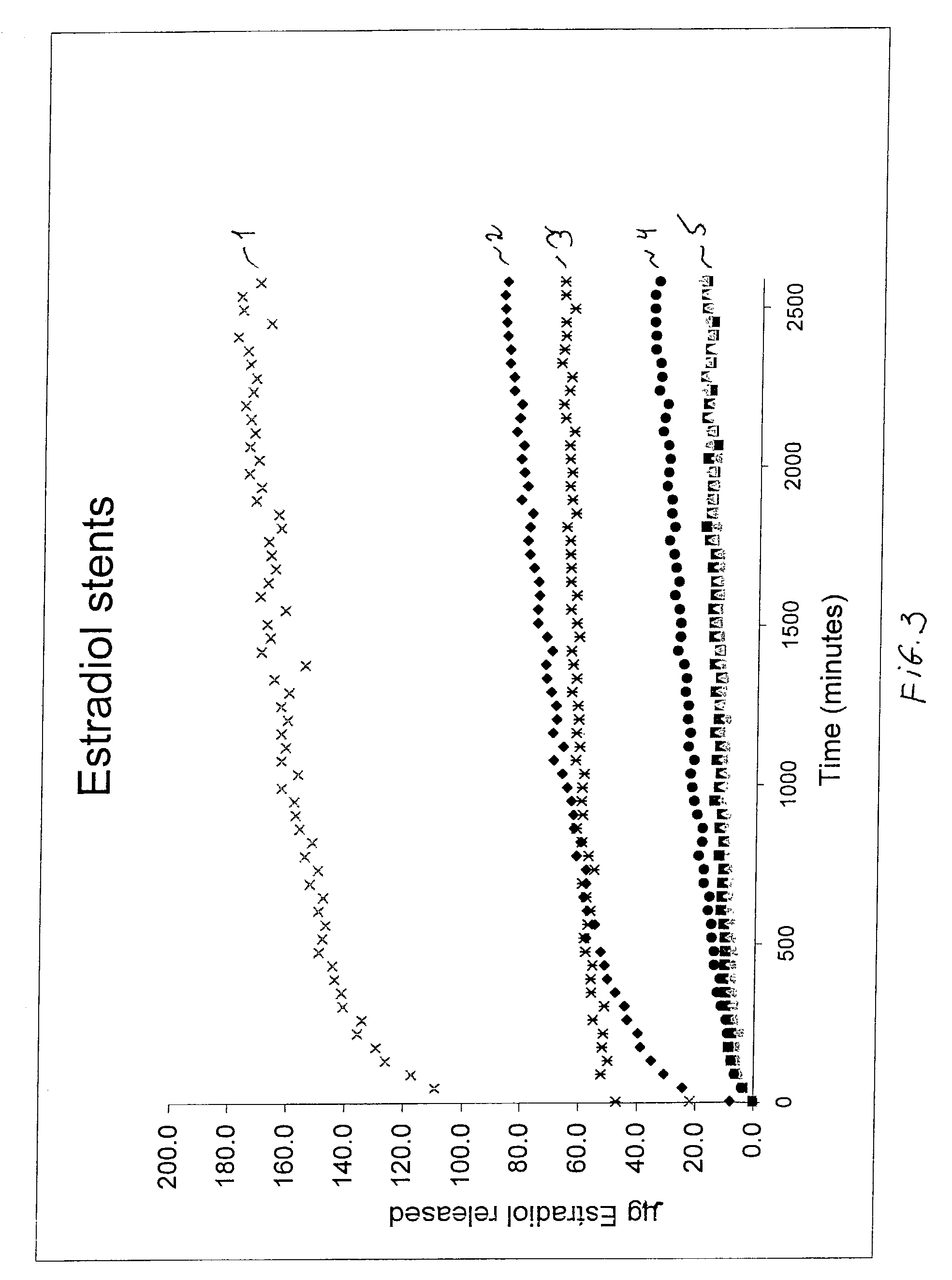Stent coatings with engineered drug release rate
a technology of drug release rate and stent, which is applied in the direction of coatings, prostheses, surgery, etc., can solve the problems of intimal flaps or torn arterial linings, affecting the patient's safety, and affecting the patient's comfort,
- Summary
- Abstract
- Description
- Claims
- Application Information
AI Technical Summary
Problems solved by technology
Method used
Image
Examples
example 1
[0037]A first composition can be prepared by mixing the following components:
[0038](a) between about 1.0 mass % and about 15 mass %, for example, about 2.0 mass % of EVAL; and
[0039](b) the balance, DMAC solvent.
[0040]The first composition can be sprayed on the surface of a bare 13 mm TETRA stent (available from Guidant Corporation). The spray can have a 0.014 fan nozzle maintained at about 60° C. with a feed pressure of about 0.2 atm (about 3 psi) and an atomization pressure of about 1.3 atm (about 20 psi). Between about 40 μg and 100 μg, for example, about 70 μg of the wet coating can be applied. The composition can be baked at about 140° C. for about 2 hours, yielding a dry primer layer.
[0041]A second composition can be prepared by mixing the following components:
[0042](c) between about 1.0 mass % and about 15 mass %, for example, about 2.0 mass % of EVAL;
[0043](d) between about 0.5 mass % and about 2.0 mass %, for example, about 1.0 mass % of estradiol; and
[0044](e) the balance, ...
example 2
[0056]A primer layer can be formed as described in Example 1. A first composition can be prepared by mixing the following components:
[0057](a) between about 0.1 mass % and about 15 mass %, for example, about 1.0 mass % of EVAL;
[0058](b) between about 0.5 mass % and about 2.0 mass %, for example, about 1.0 mass % of estradiol; and
[0059](c) the balance, DMAC solvent.
[0060]About 250 μg of the wet composition can be applied onto the dried primer layer, followed by drying, to form a drug-polymer layer.
[0061]A second composition can be prepared by mixing the following components:
[0062](d) between about 0.1 mass % and about 15 mass %, for example, about 2.0 mass % of PBMA; and
[0063](e) the balance, a solvent mixture including cyclohexanone and FLUX REMOVER in a ratio of about 30:19 by mass.
[0064]About 300 μg of the wet composition can be applied onto the drug-polymer layer, followed by drying, to form the topcoat layer.
[0065]A third composition can be prepared by mixing the following compo...
example 3
[0070]A drug-polymer layer disposed on top of an optional primer layer can be formed as described in Example 2. A first composition can be prepared by mixing the following components:
[0071](a) between about 0.1 mass % and about 15 mass %, for example, about 2.0 mass % of KYNAR; and
[0072](b) the balance, a solvent mixture including acetone, cyclohexanone and FLUX REMOVER in a ratio of about 50:25:23 by mass.
[0073]About 300 μg of the wet composition can be applied onto the drug-polymer layer, followed by drying.
[0074]A second composition can be prepared by mixing the following components:
[0075](c) between about 0.5 mass % and about 15 mass %, for example, about 1.0 mass % of KYNAR;
[0076](d) between about 0.05 mass % and about 2.0 mass %, for example, about 1.0 mass % of estradiol; and
[0077](e) the balance, a mixture of solvents including acetone, cyclohexanone and FLUX REMOVER, in a ratio of about 50:250:23 by mass.
[0078]Between about 100 μg and 175 μg of the wet coating can be applie...
PUM
| Property | Measurement | Unit |
|---|---|---|
| diameter | aaaaa | aaaaa |
| diameter | aaaaa | aaaaa |
| atomization pressure | aaaaa | aaaaa |
Abstract
Description
Claims
Application Information
 Login to View More
Login to View More - R&D
- Intellectual Property
- Life Sciences
- Materials
- Tech Scout
- Unparalleled Data Quality
- Higher Quality Content
- 60% Fewer Hallucinations
Browse by: Latest US Patents, China's latest patents, Technical Efficacy Thesaurus, Application Domain, Technology Topic, Popular Technical Reports.
© 2025 PatSnap. All rights reserved.Legal|Privacy policy|Modern Slavery Act Transparency Statement|Sitemap|About US| Contact US: help@patsnap.com



